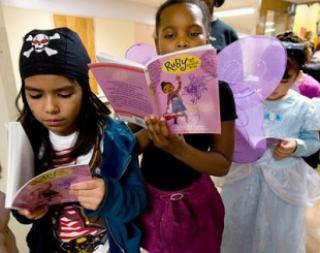Is Children's Literature Too White?

I was a child with curiosity about the whole world. I made my first explorations through books. Among my early discoveries were these: (1) the world is alive with different people and cultures, and (2) the world of books is created by, about, and for white people of Anglo-Saxon heritage.
The collection in my childhood library had a definite homogeneity, and I noticed. Looking back, I am sure I noticed because, superficially at least, few protagonists seemed like me. The girls on the covers had tiny noses and long, straight, light-colored hair. I didn't mind; I liked to imagine being other than who I was, and I liked those books! I fell in love with The Witch at Blackbird Pond, the Narnia books, and a series about a girl and a dragon in Cornwall, England. When I read The Diary of Anne Frank, I recognized myself...and that was perhaps too much reality.
At the end of the 1960s, when I was hunkering down in the library, "multiculturalism" was barely a whisper in the breeze. I personally knew only a few African Americans. One went to my school, the son of a celebrity athlete. At home, my dad lamented the violent scenes from the black civil rights movement we saw on television and my mom remembered racial segregation in the town where she had grown up, calling it a disgrace. Yet none of this seemed connected to my awareness of who was or was not represented in library books.
Some decades later, I became a mom, and my daughter is a young lady of color. I knew, particularly because I am white, that it was important to provide her with stories and pictures in which she might see herself. I hoped (and still hope!) she would connect to books, reading, and writing in many ways, in her own time...but I determined to help her first encounters with books and stories be somewhat a mirror.
I knew times had changed; I also knew the Disney entertainment machine was still foot-dragging about dark-skinned princesses. I set out with intention. At a book fair in Lower Manhattan, I greedily snapped up alphabet books illustrated with drawings of children posing in the shapes of letters. Adorable, educational, and all the children were of color. Just Us Books, co-owned by Wade and Cheryl Willis Hudson, has published children's books on black experiences and culture since 1988, and the Afro-Bets ABC Book was their first. I was encouraged.
It turned out to be laughably easy to assemble the home library we needed. Many illustrated books carefully include a brown-shaded face or two in every play group, classroom, and parade. There are now abundant books about brown-skinned children, and the stories are not always focused on diversity, justice, or ethnic cultures; it is not hard to find a picture book about a multiracial family or a family of color living their everyday lives. There are books for children about Martin Luther King, Jr., Maya Angelou, Barack Obama, and Rosa Parks as children.
But, problems remain. In bookstores I still see displayed the same, few, popular children's books with brown-skinned protagonists, over and over again. Children's booksellers often promote The Snowy Day, the 1963 Caldecott winner whose protagonist, Peter, is a black child. Recently I was disappointed, and only halfway surprised, to learn that its author/illustrator, Ezra Jack Keats, was not, in fact, African American, but instead a European Jew, like me.
Statistics tell a story. The Cooperative Children's Book Center at UW-Madison (CCBC) has studied racial and ethnic authorship and representation in American children's literature since 1985. CCBC reported for 2012 that of 3,600 children's books they received, 119 (3.3%) were about and 68 (1.8%) were by Africans or African Americans. By contrast, in 2012 approximately 14.2% of the U.S. population were African American (including those of more than one race).
We live in a pluralistic society. All of our children will, too. Let's find, read, support, and share with all children more books by and about African Americans.
Next Steps!
- Read "I See White People," a July, 2013 blog post by K.T. Horning, CCBC director.
- Read "10 Reasons Multicultural Literature is Good for ALL Children," posted January 5, 2015 by Cheryl Willis Hudson.
- The annual Coretta Scott King Book Awards, chosen by the Ethnic and Multicultural Information Exchange Round Table of the American Library Association, recognize African American authors and illustrators of books for children and young adults that demonstrate an appreciation of African American culture and universal human values. View award recipients since 1970.
- Brown Bookshelf promotes books written and illustrated for young readers by African Americans. Each February, the website makes recommendations to time with Black History Month.
- Some children's books with African American protagonists and stories, created by authors and/or illustrators of color: Please, Baby, Please by Spike Lee and Tonya Lewis Lee, illustrated by Kadir Nelson (Classic Board Books), for ages 2-5 Little Melba and Her Big Trombone by Katheryn Russell-Brown (2014, Lee and Low), for ages 6-10 Make Way for Dyamonde Daniel, the first book in a series of stories about Dyamonde Daniel by Nikki Grimes, for ages 7-9 Bud, Not Buddy by Christopher Paul Curtis (2004, Laurel Leaf; a Newbery Prize winner), for ages 8-12 The Perfect Place by Teresa E. Harris (2014, Clarion), for ages 10 and up
- We Need Diverse Books is a grassroots campaign to address the imbalance of racial and ethnic representation in children's books.
- Hear E.B. Lewis, award-winning African American children's book illustrator, describing his approach to a watercolor scene for My Rows and Piles of Coins by Tololwa M. Mollel (Houghton Mifflin Harcourt, 1999). Teaching Books offers many short videos to share with children, including "Meet-the-Author" movies.